Import, update, and export JetEngine’s Custom Post Types, Taxonomies, and Meta Box Fields data. WP Ultimate CSV Importer allows migrating JetEngine Fields linked to post types like Posts, Pages, Custom Posts, Users, WooCommerce, WP eCommerce, Categories, and Tags.
Download the below sample file to learn how to provide the value formats for JetEngine fields.
Test the import with the above file using our demo or private trial.
How to Import JetEngine Fields into WordPress #
Step 1: Begin your import by uploading the prepared file
To start the import process, you need a file in CSV/XML format that includes post-type fields and values, plus, JetEngine fields and values. Visit Ultimate CSV Importer > Import/Update and enter your file.
Next, choose the post type where you linked the JetEngine fields and click Continue.
Step 2: Drag and Drop file headers to JetEngine fields
Use the drag-and-drop mode for easy field mapping. Make sure to map the JetEngine widget fields. If you’ve added repeaters you can see a separate widget for those fields. Map them too, provide the template name at the end of the page, and Continue.
Step 3: Finally, click Import
Once all is done, just click the Import button to send the file header values to the JetEngine fields. Check the Import Log and summary file after import to view each record status.
JetEngine Repeater Field #
The CSV Importer plugin fully supports importing JetEngine’s repeater field type. To include repeater field values in your CSV or XML file, use the pipeline (|) separator between values.
For instance, if you have two repeater fields:
- Author Name(a text field)
- Post Publish Date(a date field)
You should add two columns to your CSV file, one for the author names and the other for the post-publish date. Then list the repeater values using the pipeline as shown below:
Author Name – Jack|Harry|Clara
Post Publish Date – 2020-12-04|2020-12-31|2021-01-02
This format ensures that the repeater field data is properly imported into JetEngine.
JetEngine post relations import/export #
Post Relations in JetEngine lets you build connections between post types. It is categorized in three ways: one-to-one, one-to-many, and many-to-many. To import post relations (including any and many-to-many relationships) using the WP Ultimate CSV Importer plugin, you need to add two additional columns to your CSV file alongside the existing post headers and content.
Slug – Retrieve the Post Relation slug from JetEngine and add it to your CSV.
Post Relation – Mention the ‘Post ID’ or ‘Post Title’ of the child post you want to relate to the parent post.
One-to-one relation #
One-to-one relation is used when you want to relate a single child post to a single parent post.
For example, Bus(B1, B2, B3) and Driver(D1, D2, D3) – Each bus will have unique drivers and Each driver can only drive one bus.
Post Title(B2) – Any required information
Slug – bus-and-drivers
Post Relation – D2
Download the JetEngine one-to-one relation sample file by clicking the link.
One-to-many Relations #
This is used to relate one post type to many posts in another post type.
For example, Sports (Football, Cricket) and Players(Lionel Messi, Cristiano Ronaldo, Neymar, Dhoni, Virat Kohli, Sachin Tendulkar). Each sport has many players but no one player can be in two sports.
Post Title(Football) – Your necessary info
Slug – sport-players
Post relation – LionelMessi,CristianoRonaldo,Neymar
Get the JetEngine one-to-many relation sample file by clicking here.
Many-to-many Relations #
Many-to-many relation is typically used to relate many custom post types to many different post types.
Ex: Sportshoes(Nike, Puma, Adidas) and Color(White,Green,Red) – Each Brand shoe will be in multiple colors and each color can be available in multiple shoe brands.
Post Title(Adidas) – Your necessary info
Slug- shoe-color
Post relation – White,Green,Red
Simply click the JetEngine many-to-many relation sample file link to download and access it.
How to Import JetEngine Relations #
JetEngine refactored the relationship field from scratch. It supports custom post types, custom content types, taxonomy, and user relations. Also, inside the relation, you can create meta fields that can be assigned to parent or child relations or both. You can use CSV Importer to import data to the JetEngine Relations.
To import relations, include additional fields in your CSV along with the existing field’s headers and values. One is to specify the relation post and the others are relation meta fields.
Add the field ‘jet_related_post’ and give the child post id as a value to relate the child post with the parent post.
The above is applied to one-to-one relations. Sometimes, you may have to relate multiple child posts with a parent post. Then this relation must be a ‘one-to-many’, or ‘many-to-many’ relation. For that, mention IDs in the pipeline separator like below:
124|212|347
In relations, you can create meta fields for each related post. If you want to add values to the meta fields created for the relations, specify the field headers and include appropriate values inside the CSV. JetEngine supports 9 field types for the Relations. The field types are text, date, time, datetime, textarea, checkbox, media, radio, and select.
For multiple child posts relation, follow the meta fields value format in the sample file. Separate each value with commas.
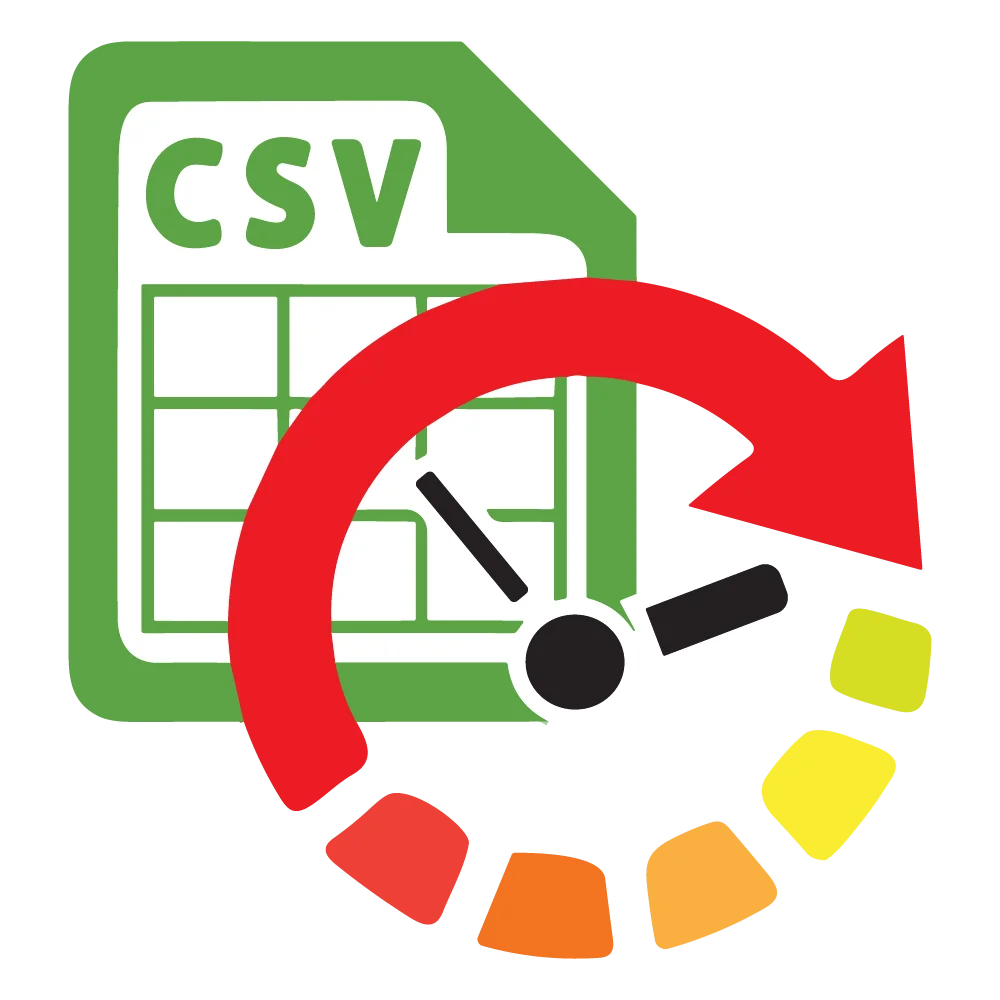
WP Ultimate CSV Importer Pro
Get Ultimate CSV/XML Importer to import data on WordPress faster, quicker and safer.
Step 1: Prepare Your CSV File
Create a CSV file with all the Relations custom fields and values. Make sure to include a field named jet_related_posts where you specify the child post IDs as values. Save the file with a .csv extension and upload it to the CSV Importer.
Step 2: Configure Post Type and Map Field Headers
Select the post type. Map the field headers from your CSV/XML to the corresponding WP Core and JetEngine fields to ensure accurate data import.
Step 3: Run the Import and Verify Results
Click Import to begin. Once the import is complete, review the log to verify the status. Check each record and download the summary log to identify any data that wasn’t imported or failed. If necessary, reimport Relations data for missed records or update incorrect values.
Export JetEngine Relations #
Exporting JetEngine Relations data is straightforward and similar to other data exports.
Step 1 – Select the Module you configured relations
On the export page, choose the module you wish to export. For Custom Post Types (CPT) or Custom Content Types (CCT), select the ‘Custom Posts’ option and then pick the CPT or CCT name from the dropdown.
Step 2: Set Export Options
Enter a name for the export file and select the desired file type (CSV, XML, etc.). Use advanced filters for more refined exports if needed (refer to our export documentation for details).
Step 3: Export and Download
Click Export to instantly generate the file. Download the exported file, which will include post relations data, Relations metafields, and other associated fields. Meta fields and post-relation headers will also display the relation ID for easy reference.
Import of Terms Field Information #
WP Ultimate CSV Importer enables you to import custom categories along with default field information into the JetEngine plugin.
Step 1: Prepare Your CSV File
Create a CSV file containing all the necessary field information for the terms you want to import. Ensure the file is correctly formatted and includes all required data.
Step 2: Upload and Map Fields
Upload your prepared CSV file to the WP Ultimate CSV Importer. Select the terms post type and use the mapping interface to link the fields in your CSV file to the corresponding fields in JetEngine.
Step 3: Launch the Import
Start the import process by clicking the Import button. Review the log to verify that the data has been successfully imported. Check your WordPress site to confirm that the terms have been added correctly.
How to Export JetEngine Fields #
Step 1: Navigate to Export
Go to the CSV Importer plugin, then switch to the Export tab.
Step 2: Choose the Module
For Custom Posts, select the ‘Custom Posts’ option and choose the desired Custom Post name from the dropdown. For Taxonomies, select ‘Taxonomies’ and then choose the taxonomy you created with the JetEngine plugin.
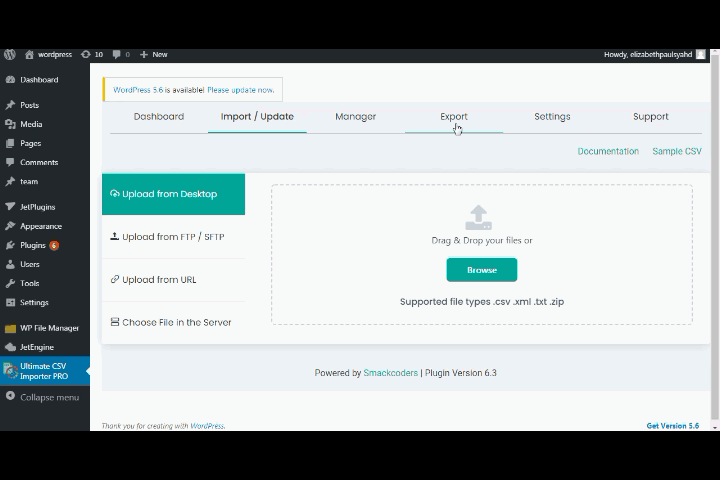
Step 3: Proceed with the Export
Click the Continue button to proceed. Follow the usual steps like configuring file type, and advanced filters for exporting data and click Export.
Step 4: Download the File
Once the export is complete, download the file to your local desktop. The file will include the JetEngine field values.

WP Ultimate CSV Importer Pro
Get Ultimate CSV/XML Importer to import data on WordPress faster, quicker and safer.
Update JetEngine Fields Data #
Step 1: Modify Your CSV File
Make the necessary updates to your existing CSV file, especially for JetEngine Fields if needed.
Step 2: Upload the Updated File
Upload the modified CSV file to the importer.
Step 3: Choose Update Content
Select the Update Content option to update current data. Choose the relevant post type or taxonomy type from the ‘Import each record as’ dropdown.
Step 4: Map the Fields
Map the fields in the updated CSV to the corresponding JetEngine fields.
Step 5: Replace Old Data
Click the Update button on the next screen to replace the old JetEngine field data with the new data. Verify the log to confirm that the updates were successful on your WordPress website.
Custom Content Types data Import Export #
JetEngine Custom Content Types import/export helps make your website faster and also keeps your website convenient for users. With WP Ultimate CSV/XML Importer you can import and export Custom Content Types of JetEngine easily into and from your WordPress website. Below you will learn how to import and update CCT CSV/XML to WordPress, and how to export Custom Content Types data of JetEngine plugin from WordPress using the WP Ultimate CSV Importer plugin. If you want to learn more about CCT please refer to official JetEngine documentation.
Once you manually create a Custom Content Type and fields inside JetEngine, the next step is to add or import values into it.
Import/Update JetEngine Custom Content Types #
Step 1: Prepare Your CSV/XML File
Ensure your CSV/XML file is ready with values for CCT fields. Refer to the sample file provided in the documentation for correctly formatting the values.
Step 2: Access the Importer
Navigate to your WordPress dashboard. Open the Ultimate CSV Importer Pro plugin.
Step 3: Upload Your File
Upload your CSV/XML file to any preferred location. Select ‘Fresh Import’ to import new CCT data. ‘Update Content’ to update existing CCT data.
Step 4: Choose JetEngine Custom Content Type
From the dropdown menu, select the JetEngine Custom Content Type you want to import or update. Click Continue.
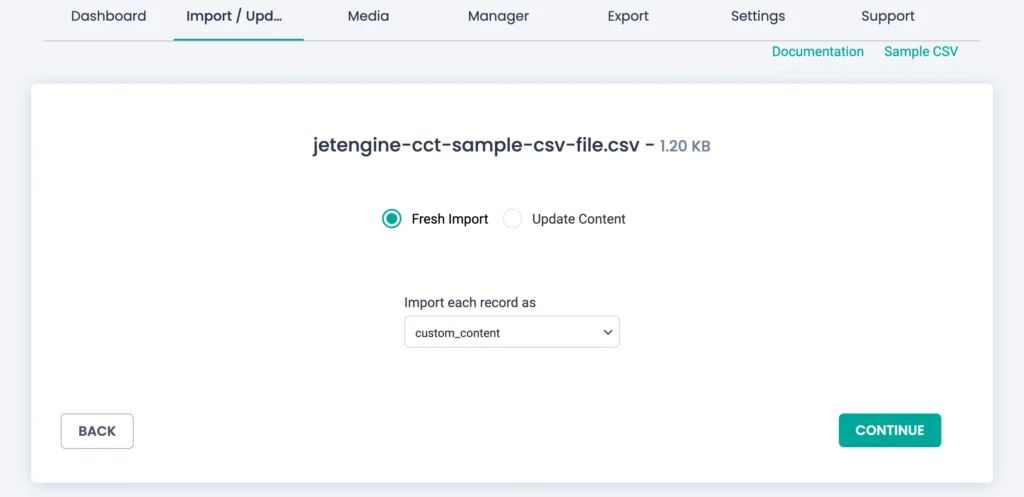
Step 5: Map CSV Headers to WP Fields
Map the CSV headers with WordPress fields, ensuring you map all JetEngine CCT fields. Save the mapping under a name using ‘Save this mapping as’ for future use. Click Continue to proceed.
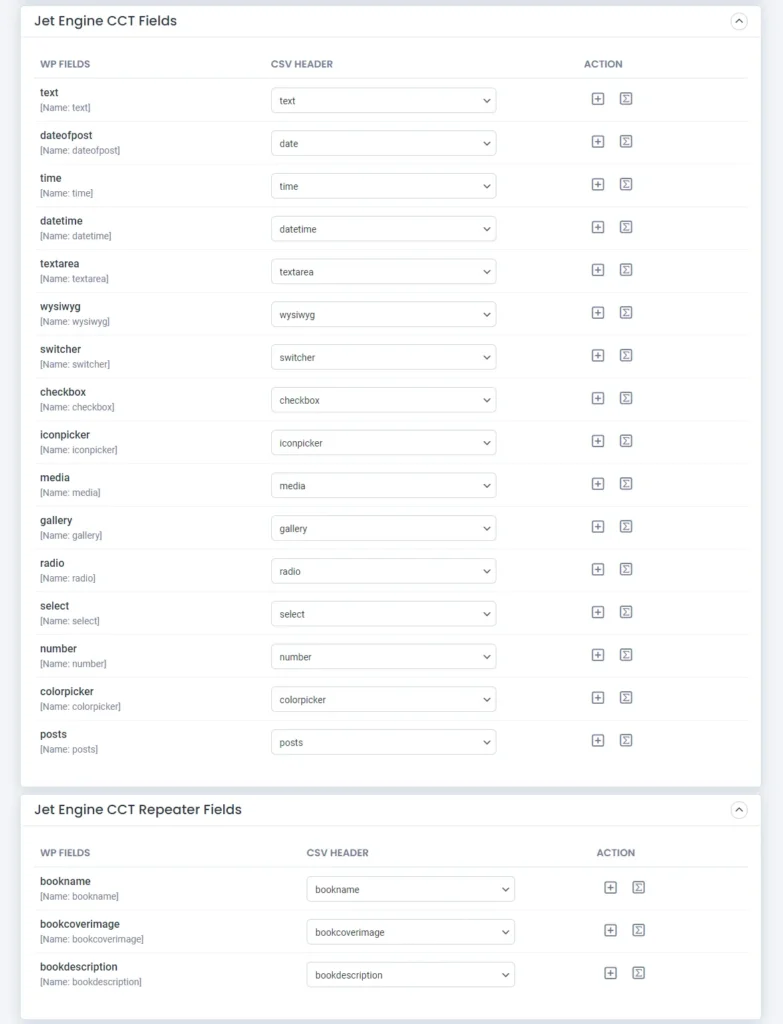
Step 6: Import or Update Data
For importing new CCT content, click the ‘Import’ button to complete the import process.
If you’re updating existing content, enable the ‘Do you want to handle duplicates for existing records?’ option. Select ID to identify the records to update. Click the ‘Update’ button to replace the old data with new values.
Export JetEngine Custom Content Types data #
Step 1: Open the Export Tab
Go to the WP Ultimate CSV Importer plugin and select the Export tab.
Step 2: Select Custom Posts
Choose Custom Posts as the module. Select your JetEngine Custom Content Type from the dropdown menu.
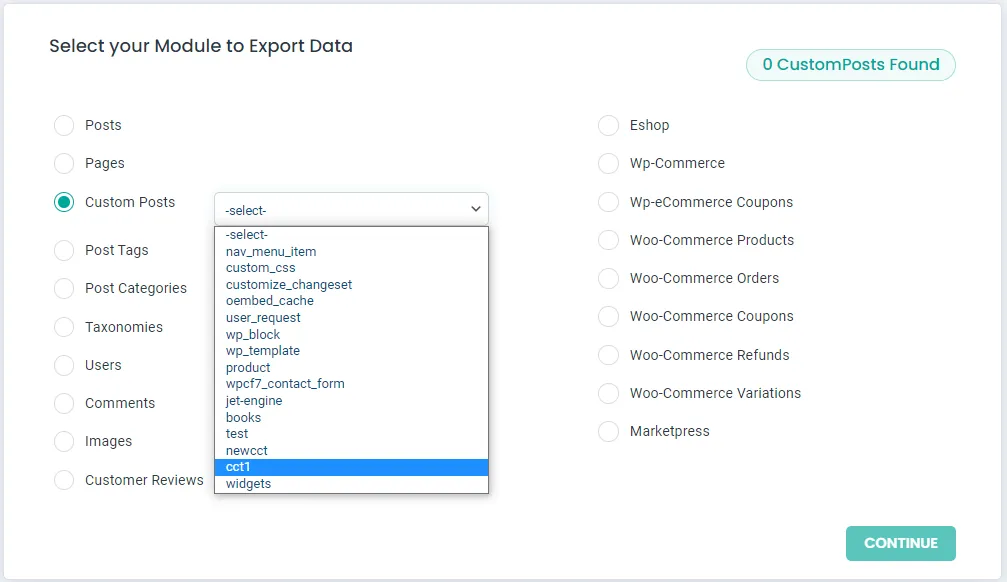
Step 3: Configure Export Settings
Provide a file name for the export file. Select the file type (e.g., CSV, XML, etc.). Use advanced filters to refine the data for export, if necessary.
Step 4: Export Data
Click the Export button to start the export process. Download the exported file to your local desktop.
Step 5: Schedule Exports
If you want to automate exports, refer to the scheduling guide in the documentation for detailed instructions.

WP Ultimate CSV Importer Pro
Get Ultimate CSV/XML Importer to import data on WordPress faster, quicker and safer.
Related Articles
1. Troubleshooting FAQs for WP Ultimate CSV Importer
2. Import WooCommerce Products from a CSV File
3. Import Images into WordPress
4. How to Import Variable Products in WooCommerce using Single CSV File
Other Useful “How-to Videos”
JetEngine Meta Fields Import and Export
Import Export JetEngine Custom Taxonomy with Custom Fields
FAQs (Frequently Asked Questions) #
1. How do I export my JetEngine listing?
To export your JetEngine listing, you typically need to use the built-in export functionality provided by the JetEngine plugin. Here are the step-by-step instructions on how to do it:
- Access your WordPress Dashboard: Log in to your WordPress website where JetEngine is installed.
- Navigate to JetEngine Listings: Look for the “JetEngine” menu item in the WordPress dashboard. Hover over it, and then click on “Listings”.
- Select the Listing to Export: Choose the listing you want to export from the list of available listings.
- Export the Listing: Look for an option to export the listing. This could be in various formats such as CSV, XML, JSON, etc. The exact method may vary depending on the version of JetEngine you’re using and any additional plugins or extensions you have installed.
- Follow Prompts: Once you select the export option, follow any on-screen prompts or instructions to complete the export process.
- Download the Exported File: After the export process is complete, you’ll typically be given a link to download the exported file. Click on this link to download the file to your local computer.
- Verify the Exported File: Before you proceed, it’s a good idea to verify that the exported file contains all the data you need. You can open it using a text editor or spreadsheet software to ensure that the data is intact.
- Save the Exported File: Save the exported file to a safe location on your computer for future reference or for importing into another system if needed.
Remember, the exact steps may vary slightly depending on the version of JetEngine you’re using and any customizations you’ve made to your WordPress website.
2. How do I import taxonomy into WordPress?
To import taxonomy into WordPress, you typically have a few options depending on the complexity of your taxonomy structure and your technical expertise:
- Manual Entry: If you have a small number of taxonomy terms, you can manually enter them using the WordPress dashboard. Simply navigate to the “Posts” or “Custom Post Types” section, click on “Categories” or “Tags” (depending on the taxonomy you want to add), and then click on “Add New” to create individual terms.
- CSV Import: If you have a large number of taxonomy terms or want to import them from an external source, then install the WP Ultimate CSV Importer Pro plugin that supports importing taxonomy terms from CSV files. These plugins allow you to map CSV columns to taxonomy fields and import terms in bulk.
- Custom Script: For more advanced users, you can write a custom script using WordPress functions like wp_insert_term() to programmatically import taxonomy terms from an external source. This method requires some coding knowledge but provides more flexibility and control over the import process.
3. How do I export a WordPress listing?
To export a WordPress listing, you can follow these steps:
- Navigate to the Listings Section: Log in to your WordPress dashboard, and go to the section where your listings are managed. This could be a Custom Post Types import/export or managed by a specific plugin like JetEngine or another directory plugin.
- Select the Listings to Export: Choose the listings you want to export. You may have options to filter or select specific listings based on categories, tags, or other criteria.
- Export Listings: Look for an export option within your listings management interface. Depending on the plugin or method you’re using, this could be a built-in export feature or a third-party plugin that allows you to export listings to a CSV, XML, or JSON file format.
- Choose Export Format: Select the desired file format for your export. CSV is commonly used for exporting data that can be opened in spreadsheet applications like Excel. At the same time, XML and JSON are more suitable for structured data that may be imported into other systems or websites.
- Confirm and Export: Follow any on-screen prompts or instructions to confirm the export process. Once confirmed, the plugin or tool will generate the export file containing your listing data.
- Download Exported File: After the export process is complete, you’ll typically be provided with a download link or option to save the exported file to your computer.
4. How do I export taxonomy from WordPress?
You can export taxonomy from WordPress using plugins or custom scripts.
- Taxonomy Export Using Plugins: Install and activate the WP CSV importer pro plugin. Navigate to its settings, and select the taxonomies you want to export. Provide the file name and the file format. You can also export the file using an advanced filter. Then, initiate the export process to generate the export file.
5. Difference between JetEngine CPT and CCT?
Both Custom Post Types (CPTs) and Custom Content Types (CCTs) in JetEngine allow you to create custom data structures in WordPress. However, they differ in how they store and manage data, which directly impacts performance and flexibility.
Custom Post Types (CPTs)
CPTs are a core WordPress feature, storing their data within default WordPress database tables such as wp_posts and wp_postmeta. Each CPT item is saved in the wp_posts table, while its custom fields are stored in wp_postmeta. While CPTs are well-integrated with most plugins, they may not be ideal for large datasets. Since metadata is stored in a separate table (wp_postmeta), this can lead to database overload and performance issues when managing extensive amounts of data.
Custom Content Types (CCTs)
CCTs, on the other hand, are a JetEngine-specific feature. They create separate database tables for each CCT, storing each item and its associated data within a single row in that table. This approach enhances database performance and is better suited for handling large datasets with numerous custom fields.
6. How to Create Meta Fields in JetEngine?
To create meta fields,
- Navigate to JetEngine > Meta Fields and click Add New to create the new Meta Box.
- Provide a title and configure for which post type you want to associate the Meta Box with.
- Start to add fields by using the New Meta Field button under the Meta Fields section.
- At last, after adding the fields, click ‘Add Meta Box’ to apply the changes.
7. What JetEngine Fields are Supported in WP Ultimate CSV Importer?
WP Ultimate CSV Importer supports all the field types the JetEngine plugin offers. If you think we’ve missed something, or you need additional features, just reach out to us at [email protected] We’ll add that for you.
